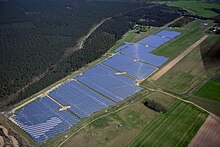Eggersdorf airfield
| Eggersdorf airfield | ||
|---|---|---|
|
|
||
| Characteristics | ||
| ICAO code | EDCE | |
| Coordinates | ||
| Height above MSL | 68 m (223 ft ) | |
| Transport links | ||
| Distance from the city center | 3 km southwest of Müncheberg, 50 km east of Berlin |
|
| Basic data | ||
| opening | 1936 | |
| operator | Airfield operator company Eggersdorf / Müncheberg mbH |
|
| Start-and runway | ||
| 06/24 | 1200 m × 40 m grass (of which 400 × 37.30 asphalt) | |
The Eggersdorf airfield is a special airfield next to the Eggersdorf district of the city of Müncheberg in the Brandenburg district of Märkisch-Oderland , about 50 km east of Berlin .
Data
The airfield is approved for a maximum take-off weight of 5700 kg. In addition to the main runway, the field also has a specially designated glider operating area of around 1200 m in length.
history
Eggersdorf airfield was created around 1938 as a military alternative airfield for the Luftwaffe . The aircraft pilot schools in Frankfurt (Oder) (April 1938 - January 1945) and Fürstenwalde (November 1939 - August 1944) used it as a training area. In the final phase of World War II parts were the Attack Unit 9 and several fighter units of Jagdgeschwader 51 and Jagdgeschwader 54 in Eggersdorf and flew from here missions against the advancing Red Army . On the night of April 18, 1945, Soviet night bombers raided the field and, after the remaining air force units had withdrawn that afternoon, they were occupied by Soviet ground forces on April 19. The Soviet air forces also moved some fighter units to Eggersdorf, which flew a few missions until the end of the war.
After the end of the Second World War in 1945, the square was used by the group of Soviet occupation troops in Germany for two years ; from 1947 to 1952 the square was unused. From 1952 the place was used as a training center for gliding and parachuting . 1957 began the renewed use by the motorized aviation. The air sports activities ended in 1968 when it was taken over as an NVA air base . In the same year, the airfield began to be used as a decentralization airfield for JG-8 , after an expansion by the BPiB-14 (construction pioneer battalion) had taken place from 1966. The pilots of the JG-8 also performed their annual mandatory parachute jumps in Eggersdorf. The operator of the airfield was the so-called Feldflugplatzkommando Müncheberg , which was renamed Feldflugplatzkommando-8 on December 1, 1971 and incorporated into the FTB-8 (Aviation Technical Battalion). The nickname of the place was brass . The radio and air traffic control devices were operated by the message and air traffic control train (belonged to the NFB-8 (message and air traffic control battalion) code name: Profileisen 70 ). In addition, a radio station for the NFB-8 intelligence company was deployed at the airfield. From 1986 Eggersdorf was included in the school operation of the TG-44 , whose members practiced taking off and landing with the Tu-134A on unpaved areas.
The military use of the square was discontinued in 1990 and the facilities and equipment were dismantled.
With the founding of the glider pilot club (1990) and the ultralight flight school (since 1991) Eggersdorf is again available for civil aviation and in 1993 was approved as a commercial airfield. Today in Eggersdorf, in addition to being used as a landing pad, ultralight aircraft are manufactured on the premises. There is the first and only flyer village in Germany, the air base with eight halls and integrated living area.
In August 2012, a part of the airfield of around 40 hectares was converted into a solar park. Associated with this was a shortening of the runway for powered flight from 2350 m to now 1200 m.
Incidents
On July 19, 2020, an ultralight aircraft flew into the tower. The two inmates were injured.
literature
- Jürgen Zapf: Airfields of the Air Force 1934–1945 - and what was left of them. Volume 1 Berlin and Brandenburg . VDM , Zweibrücken 2001, ISBN 3-925480-52-8 .
- Thomas Bussmann: Reinforced concrete, grass and railway lighting. The military airfields of the GDR . MediaScript, Cottbus, Berlin 2011, ISBN 978-3-9814822-0-1 .
Web links
Individual evidence
- ^ Stefan Büttner: Red places. Russian military airfields Germany 1945–1994.Fliegerhorste – aerodrome – military fallow. AeroLit, Berlin 2007, ISBN 978-3-935525-11-4 , p. 111.
- ↑ Small plane flies in the tower of the airfield near Berlin - two injured
- ↑ Near Berlin: Small aircraft flies in the airfield tower (video)


